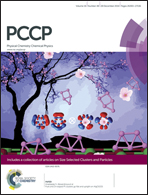Computational studies of electrochemical CO2 reduction on subnanometer transition metal clusters†
Abstract
Computational studies of electrochemical reduction of CO2 to CO, HCOOH and CH4 were carried out using tetra-atomic transition metal clusters (Fe4, Co4, Ni4, Cu4 and Pt4) at the B3LYP level of theory. Novel catalytic properties were discovered for these subnanometer clusters, suggesting that they may be good candidate materials for CO2 reduction. The calculated overpotentials for producing CH4 are in the order, Co4 < Fe4 < Ni4 < Cu4 < Pt4, with both Co4 and Fe4 having overpotentials less than 1 V. Investigation of the effects of supports found that a Cu4 cluster on a graphene defect site has a limiting potential for producing CH4 comparable to that of a Cu (111) surface. However, due to the strong electronic interaction with the Cu4 cluster, the defective graphene support has the advantage of significantly increasing the limiting potentials for the reactions competing with CH4, such as the hydrogen evolution reaction (HER) and CO production.

- This article is part of the themed collection: Size Selected Clusters and Particles: From Physical Chemistry to Catalysis

 Please wait while we load your content...
Please wait while we load your content...